The conservation of the Dragon's blood tree (Dracaena cinnabari) on the island of Socotra
With contributions from Bruno Mies
Article first posted: 01. October 2009

Figure 1. Dracaena cinnabari, Dixem Plateau. December 2008.
In December 2008, I took the opportunity to pay my first visit to the island of Socotra, located just off the Horn of Africa. Socotra is regarded by some people as the 'Galapagos of the Indian Ocean' due to the high degree of endemism found in both the flora and fauna. For instance, of the roughly 828 vascular plant species known from the Socotra Islands, 307 (37 %) are endemic (Miller & Morris 2004). On the first few days of our trip, we were accompanied by two birdwatching friends from Kuwait, Abdelrahman and Pekka, and the bird report can be found here. After we had spotted all of the endemic birds (although I missed out on the Socotra Bunting), and Abdelrahman and Pekka had left, most of my time was devoted to the flora and vegetation of the island. One fact that struck me was the degree of vegetation degradation being caused by overgrazing - it seems that with the recent opening up of the island, large numbers goats are being transported to all accessible areas, with negative implications for the flora and vegetation. The same has happened on the Canary Islands, which are also characterised by a high degree of endemism and which I have visited on many occasions. Despite the fact that the two archipelagos are located over 7000 km apart, they display a remarkable number of similarities in vegetation structure and general flora. This article deals with the conservation of Dragon's blood tree (Dracaena cinnabari) on Socotra, and a very similar species, D. draco, occurs in comparable habitats on the Canaries. There too, it is suffering from the same pressures as on Socotra.
As a flagship species that is a highly conspicuous element of parts of the landscape of Socotra, specifically between about 300 and 1480 m, the endemic Dragon's blood tree, Dracaena cinnabari, has been a focus of conservation efforts and research activities in recent years. Several detailed studies have been conducted to assess the potential impacts of various environmental factors, in particular climate change, on the long-term survivability of Dracaena populations (e.g. Attorre et al. 2007, Habrova et al. 2009), because it had already been noted by various authors (e.g. Beyhl 1996, Mies 2001, Adolt & Pavlis 2004, Miller & Morris 2004) that regeneration in many natural populations is very low. Miller & Morris (2004) cautiously rule out grazing as a prime cause for the lack of recruitment, except where the local populations are already under stress from presumed aridity. It is clear that the gradual decline of Dracaena is a result of a general aridification of the island (and the wider region as a whole) that has been taking place over a very long time-scale. Dracaena woodlands on Socotra are relicts of the Mio-Pliocene thermo-sclerophyllous southern Tethys flora (i.e. Laurasian subtropical flora), and have therefore presumably been in decline for the past several million years. However, our own superficial observations indicate that a more recent acceleration of this decline can almost certainly be attributed to overgrazing, either directly or indirectly, including in some of the more wetter regions of the island. This is in part corroborated by the results of a recent study by Habrova et al. (2009), who examined changes in population size on Jebel Skant over a 100-year period. They managed to relocate the approximate site ("Jebel Dried") from where Kossmat had taken a photograph of Jebel Skant in 1899 (and later published by Wettstein 1906) during an Austrian expedition to the island. Numerous individual Dracaena trees were clearly discernible on this image. In 2004, new images of Jebel Skant were taken from roughly the same location used by Kossmat, allowing for a direct comparison after almost exactly 100 years. Despite minor technical problems with the comparison (due to slightly different locations from where the two sets of photographs were taken) and the less favourable lighting conditions in 2004, it is clear that there has been a substantial reduction in the population size of Dracaena on Jebel Skant. The authors estimated that there has been a decrease of just over 40 % in the number of trees. Significantly, it appears as if regeneration of the species is severely hampered, as indicated by the low number of younger trees that were visible in 2004. If conservation of the natural Dracaena stands is the stated aim, detailed studies are required to address key questions regarding the autecology and population dynamics of the species. Some studies have recently been completed, but before awaiting the outcome of others, active intervention measures, such as the transplanting of nursery-grown plants would seem highly advisable, as is currently being undertaken by the local Environment Protection Agency on the Dixem Plateau (Figure 2).
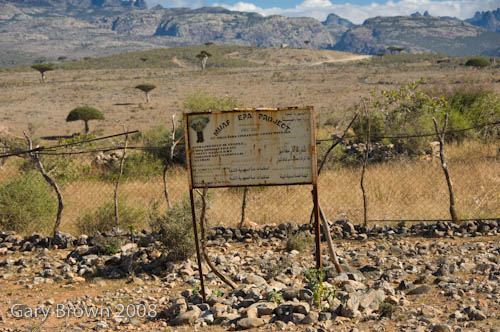
Figure 2. Dracaena cinnabari nursery established by the Socotra Environment Protection Agency. Dixem Plateau. December 2008.
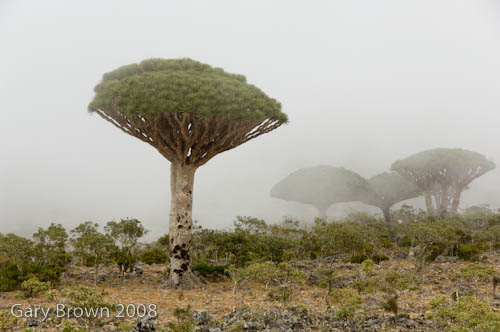
Figure 3. Dracaena cinnabari woodland in a mist-affected area of the Dixem Plateau. December 2008.
Several authors, including Mies (2001) and Miller & Morris (2004), have remarked that the best stands of Dracaena are found in the areas most affected by the monsoon clouds and mists (Figure 3), especially at higher elevations (as on Jebel Skant), and that, with the exception of various small populations, sometimes consisting of an individual tree, the species is largely restricted to the Haggeher Mountains and Hamaderoh on the north-east coast. More recently Attorre et al. (2007) have shown the current distribution to correlate with three main factors: (1) moisture index (ratio of mean annual precipitation and potential evapotranspiration), (2) mean annual temperature and (3) slope. According to these authors, Dracaena occurs in areas with a mean annual precipitation ranging from 207 - 569 mm. According to this model, Dracaena cinnabari occupies only about 5 % of its potential habitat on Socotra. The authors also suggested that increased aridity (due mainly to climate change) will reduce the potential habitat of the species substantially by 2080, by up to about 50 %. Only three areas, Skant, Deidho and Dixem, were shown by environmental modelling to allow natural populations of Dracaena to thrive on Socotra, assuming grazing can be restricted, which is currently not the case for Dixem. Mies (2001) underlined the importance of nursery plants for the successful recruitment of Dracaena in areas exposed to grazing, such as on the Dixem Plateau, and Miller & Morris (2004) note that regeneration is problematic in relict populations that lack a dense understorey of shrubs. The effects of grazing as shown in Figure 4 (an exclosure protecting the above-mentioned Dracaena nursery on the Dixem Plateau) make it abundantly clear why Dracaena is unable to regenerate in such areas - vegetation cover has been almost completely denuded outside of exclosures. In some areas, older Dracaena trees are one of the few conspicuous signs of plant life in an otherwise virtually barren landscape (Figure 5). It should also be borne in mind that not only is the protective perennial vegetation layer missing in such overgrazed areas, but that as a consequence, soils often become seriously degraded, in particular due to the loss of the thin organic topsoil. Germination per se does not appear to be problematic in Dracaena.
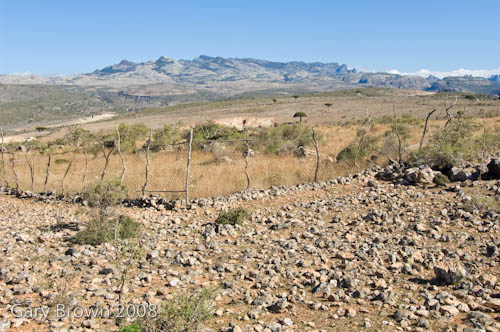
Figure 4. Dracaena cinnabari nursery illustrating the effects of exclosure. Dixem Plateau (see also Figure 2). December 2008.
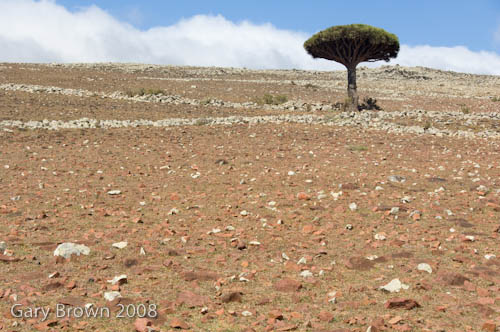
Figure 5. Dracaena cinnabari in an otherwise virtually barren, severely degraded landscape. Dixem Plateau. December 2008.
Adolt & Pavlis (2004) note a "certain uniformity" of the age structure of Dracaena stands, and this is likely to be consistent with the rare recruitment success in many areas. It can be inferred from this observation that seedling mortality will be 100 % in years of poor rainfall, especially in the more unfavourable sites. Furthermore, for such a long-lived species as Dracaena, it can be assumed from ecological theory that successful recruitment will be, and need only be a rare event for the population to survive. It is unclear as to how often such "windows of recruitment opportunity" occur on Socotra, but in any case, assuming equal rainfall, establishment of plants is likely to vary substantially with the nature of the substrate, specifically its water-holding capacity, the degree of shading, and not least the amount of trampling by livestock.
Apart from a positive correlation with moisture index and annual temperature, Attorre et al. (2007) found that the current distribution of Dracaena is also linked to slope. It has been frequently observed (e.g. Beyhl 1996, Mies 2001, Miller & Morris 2004) that young plants of the species usually now grow on cliff ledges and other inaccessible sites for goats (Figures 6 and 7), but are absent from the surrounding area. This has also long been noted for the Macaronesian Dracaena draco (e.g. Kunkel 1980). Apart from the grazing factor, which undoubtedly plays a major role, some of these sites, which represent in the literal sense "safe sites" for recruitment, are probably also characterised by better water storage capacity, allowing seeds to germinate and become established even in years of less than ideal rainfall.

Figure 6. Dracaena cinnabari, age class 1, on an inaccessible ledge. Dixem Plateau. December 2008.
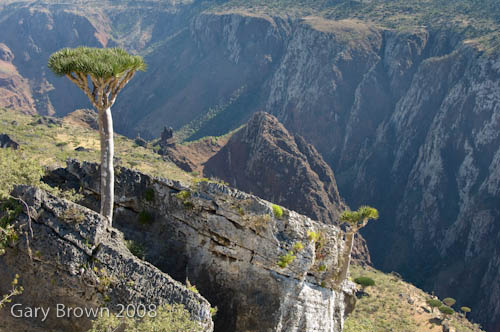
Figure 7. Dracaena cinnabari, age class 3, on huge limestone blocks. Dixem Plateau. December 2008.
For monocots, including for D. cinnabari, it is virtually impossible to precisely assess the age of trees using morphological or anatomical features. For practical purpose in the field, four morphological ages classes of Dracaena can be distinguished (1) single rosette, no trunk, (2) plant with trunk and a single terminal rosette (Figure 8. 85442) (3) Plant with trunk, initially branching and several rosettes, crown diameter usually less than 2.5 m, (4) plant with a crown diameter in excess of 2.5 m, dense dracoid ramification. Adolt & Pavlis (2004) estimate the mean ages of three separate mature populations of D. cinnabari at Firmihin, belonging therefore to age class 4, to be between 200 and 300 years old, and a population at Hamadero in the north-east of the island to be about 230.
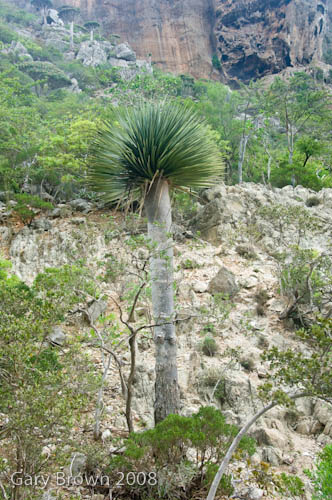
Figure 8. Dracaena cinnabari, age class 2. North-facing slope near Hadiboh. December 2008.
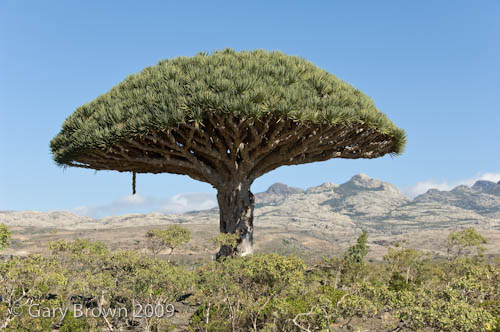
Figure 9. Dracaena cinnabari, age class 4. Dixem Plateau. December 2008.
In order to protect natural self-reproducing populations of Dracaena, Attorre et al. (2007) recommended that the boundaries of the Skant Nature Sanctuary should be extended to encompass Deidho in the eastern part of the Haggeher Mountains.
Although this article has focused on Dracaena cinnabari, other tree species on Socotra, including species of frankincense (Boswellia), are suffering from the effects of excessive grazing pressures, and in some cases, are being cut down in unsustainable numbers for firewood.
References
Adolt, R. & Pavlis, J. (2004): Age structure and growth of Dracaena cinnabari populations on Socotra. - Trees 18: 43-53.
Attorre, F., Francesconi, F., Taleb, N., Scholte, P., Saed, A., Alfo, M. & Bruno, F. (2007): Will dragonblood survive the next period of climate change? Current and future potential distribution of Dracaena cinnabari (Socotra, Yemen). - Biological Conservation 138: 430-439.
Beyhl, F.E. (1996): Attempts at raising the Soqotran Dragon tree, Dracaena cinnabari outside the island. - In: Dumont, H.J. (ed.): Proceedings of the First International Symposium on Soqotra Island: present and future. United Nations, New York, pp. 125-133.
Habrova, H., Cermak, Z. & Pavlis, J. (2009): Dragon's blood tree - Threatened by overmaturity, not by extinction: Dynamics of a Dracaena cinnabari woodland in the mountains of Soqotra. - Biological Conservation 142: 772-778.
Mies, B.A. (2001): Flora und Vegetationsölogie der Insel Soqotra. - Essener Ökologische Schriften 15. Westarp Wissenschaften, Hohenwarsleben, Germany.
Miller, A.G. & Morris, M. (2004): Ethnoflora of the Socotra Archipelago. - Royal Botanic Garden Edinburgh.
Wettstein, R. von (1906): Socotra. - In: Karsten, G. & Schenk H. (eds.): 'Vegetationsbilder' 3: 25-30 Gustav Fischer Verlag, Jena.